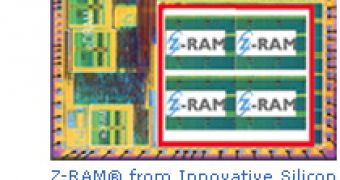Innovative Silicon (ISi for short) announced that it licensed its Z-RAM computer memory technology to the hardware manufacturer Hynix Semiconductor, entering a partnership that could lead to a new RAM standard. While this new memory technology is not expected to make it to users' machine before 2010, it could be the single most important step forward since the DRAM industry adopted the CMOS technologies.
According to the hardware news site TGDaily, Isi will work closely with Hynix in order to produce commercial quality memory modules that are compatible with computer systems that are in use today. ISi says that Z-RAM offers a number of advantages over the traditional DRAM design that is used now as it uses a capacitor-less "bitcell" configuration, that can be packed in twice the densities possible with DRAM modules and about five times more compact than the cache memory standard. When compared with DRAM, Isi's Z-RAM will be faster and use less energy and at the same time the same basic design can be optimized towards speed or power efficiency. Isi's operational memory modules reach up to 500MHz and while this is much slower than the cache memory, it could hold five times more data on the same die size and use less power too.
Because the ISi Z-RAM design needs no capacitors inside the memory chips like the traditional DRAM design does, less elaborated manufacturing processes are required, while costs are going down too. Z-RAM uses the Silicon-On-Insulator (SOI for short) fabrication process because of its "floating body effect". According to the Innovative Silicon company, at least 25 patents have already been submitted while 50 more concerning the bitcell technologies, support circuitry and interface architectures are pending.
Among the hardware companies that licensed Isi's Z-RAM technology there is AMD that is supposed to launch later processors with a large level 3 of cache memory implemented using the Z-RAM standard. AMD entered a license agreement with ISi over the first generation of Z-RAM in 2006 and a few months later expanded the agreement to include the second generation as well. Z-RAM memory modules that are using the second generation fabrication process are a little bit faster and can hold a bit charge 25x longer than the first generation ones.

 14 DAY TRIAL //
14 DAY TRIAL //